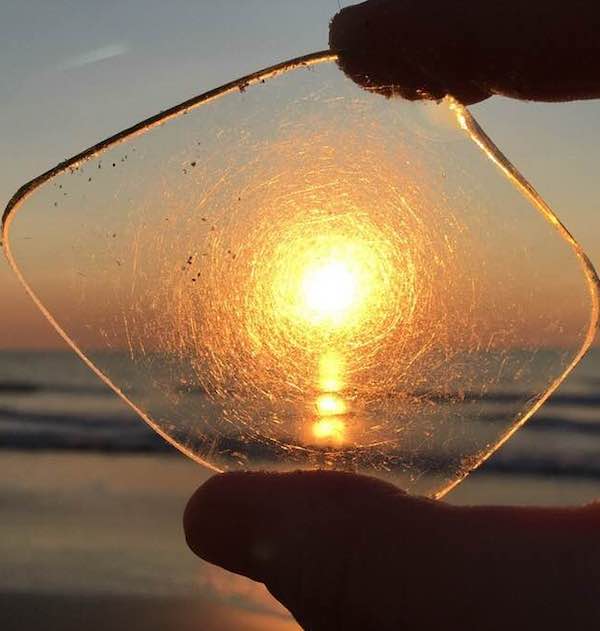
South Carolina sunrise through a piece of beach glass. Image via Fran Aquino.
What are the brightest objects in our solar system that you can see in your sky? The sun is the very brightest, of course, but you might be surprised by some of the other objects that make the list. You can see the first seven objects on this list using just your eyes, even from cities and suburbs. The last items on the list are fainter and therefore more challenging, and likely require a dark-sky site and some optical aid.
In astronomy, the brightness of objects is measured by what’s called magnitude. The lower the number, the brighter the object. So, 1st-magnitude objects indicate the brightest stars in our sky, 2nd-magnitude fainter ones, 3rd-magnitude fainter still, and so on. Note that some objects, some planets for example, are even brighter than 1st magnitude, peaking in negative numbers at their brightest.
Without optical aid, the human eye can see objects to around 6th magnitude, in optimum conditions and under dark skies. There are about a dozen natural solar system objects that are, in theory, visible to the unaided eye. In practice, the fainter ones are very difficult to see with the eye alone, but perhaps possible for those keen vision and true darkness.
Transient objects, such as very bright meteors or comets, aren’t included in this list. Extraordinary meteors can turn the night sky as bright as day, and some comets reach stunning brightnesses, too, such as Ikeya-Seki in 1965, which reached a whopping -10 magnitude and could be seen at noon. But because they’re only in the sky on a temporary basis, and not something that can regularly or consistently be observed, these objects aren’t included here. We also don’t include manmade objects, such as satellites and the International Space Station. Try the Heavens-Above website, if you’re interested in observing human-made Earth-orbiting objects.
Here are the top 12 brightest natural solar system objects, in order from brightest to dimmest:
1. The sun. No surprise here. The sun shines at magnitude -26.7. Technically, the sun can’t even be looked at without special safety filters to protect your eyes. Gazing at the sun directly without special protective filters can cause blindness. That said, now would be a good time to equip yourself with filters for solar observing, and to begin a program of regular sun viewing. You might know that the sun increases and decreases in activity in a cycle lasting 11 years. The new cycle – Solar Cycle 25 – was officially announced in September 2020. At EarthSky Community Photos, we’re beginning to see more sunspots! And more are surely coming, increasing in number to a peak five or so years from now.
Read more: Top 7 tips for observing the sun safely
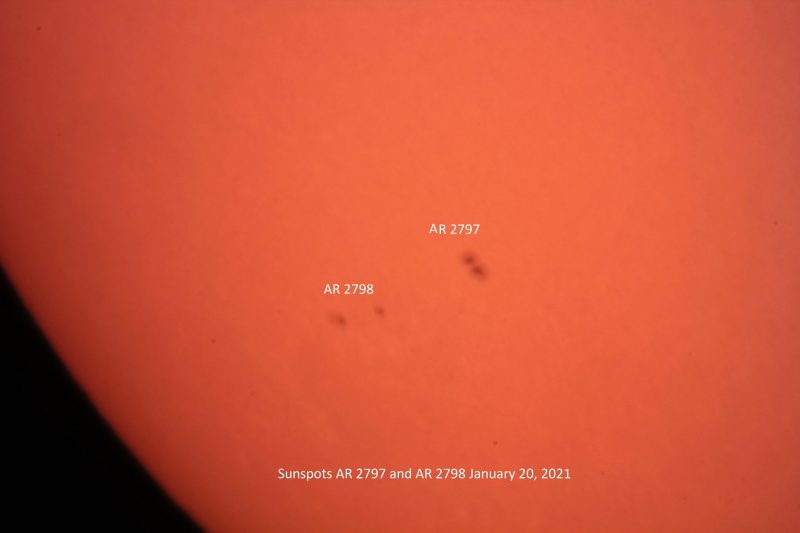
View at EarthSky Community Photos. | Victor C. Rogus wrote on January 20, 2021: “The sunspot formerly known as AR2797 has split in two: AR2797 and AR2798. Trailing sunspot AR2798 is crackling with C-class solar flares.” Thank you, Victor!
2. The moon. The moon varies in brightness depending on what phase it’s in. At its full phase when it’s the brightest, it tops out at magnitude -12.7. On the other hand, the moon in its crescent phase shines at only about magnitude -6. If you’re a deep-sky observer, the moon is bright enough to ruin your night vision, meaning it’ll prevent you from getting the best view of distant, faint star clusters, nebulae and galaxies. If you’re using a telescope, the moon should be your last stop during a night of observing. To the eye alone, though, there’s nothing more beautiful than a bright moon shining in the night sky, casting its light and creating moon shadows in the landscape all around you. Visit EarthSky’s moon phases page to learn the dates of major moon phases throughout 2020.
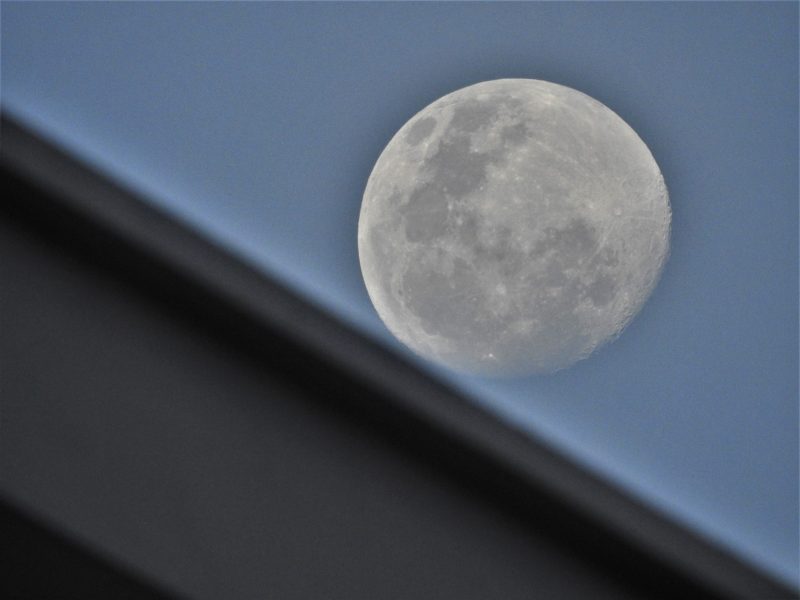
View at EarthSky Community Photos. | Kannan A in Singapore captured this image on January 26, 2021, and wrote: “The waxing gibbous moon rising from behind the apartment block. The moon was 94.1% illuminated and distance from Earth was 391,375 km [243,000 miles] away from Earth when this photo was taken. It was still very much a day moon, as the skies were still bright at this time.” Thank you, Kannan A!
3. Venus. The closest planet to Earth, one step inward in orbit around the sun, is also the brightest planet. It can shine as brightly as magnitude -4.7, bright enough to be seen in daylight if you know just where to look. The brightness of Venus is thanks in part to its proximity to Earth and also, largely, to its thick, reflective clouds. As with all the other solar system objects, Venus varies in brightness depending on a number of factors, including how close it is to Earth and what phase it’s in. Yes, as a planet orbiting inward from Earth, Venus shows phases! Venus was in our morning sky – in the east before sunrise – throughout late 2020. Soon, though, it’ll be gone from our skies for a few months, traveling behind the sun from Earth. Venus will return to our evening sky in May 2021. Find Venus’ location for each month in EarthSky’s planet guide.
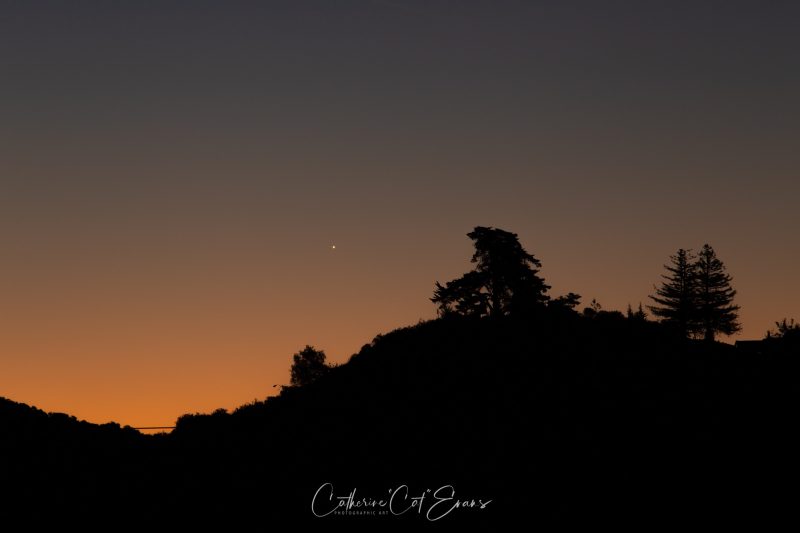
View at EarthSky Community Photos. | Catherine Evans caught Venus near daybreak on January 17, 2021, from the Edna Valley in San Luis Obispo, California. She wrote: “Closer and closer to the sunrise, so it won’t be seen much longer.” So true, Catherine! Thank you. Even into early February 2021, if you have a clear sky to the eastern horizon, you might still be able to snag a last look at Venus. Look very low in the east before sunup. If you can’t see it, try sweeping with binoculars.
4. Mars. The red planet is the second-closest planet to Earth after Venus, and it doesn’t often reach its maximum magnitude of -2.9. But when it does … wow! What a sight to behold. Just like other planets outside Earth’s orbit, when Mars is brightest around the time of its opposition, when it’s opposite the sun from Earth, rising in the east as the sun sets in the west. Mars’ oppositions come when our faster Earth moves between Mars and the sun. That happens about every two years. Some Mars oppositions are better than others. Mars was particularly bright in 2018, and its last opposition – around mid-October 2020 – was a good one, too. For about a month around the 2020 opposition, Mars was brighter than Jupiter. At other times (in fact, most of the time), Mars is relatively faint. Sometimes it’s very faint indeed, when it’s on the far side of the solar system from us, shining across its nearly-maximum distance from Earth (about 250 million miles, or 400 million km). After all, Mars is just a little planet, littler than Earth. So its brightness waxes and wanes dramatically as we and Mars move around the sun. Find Mars’ location for each month in EarthSky’s planet guide.
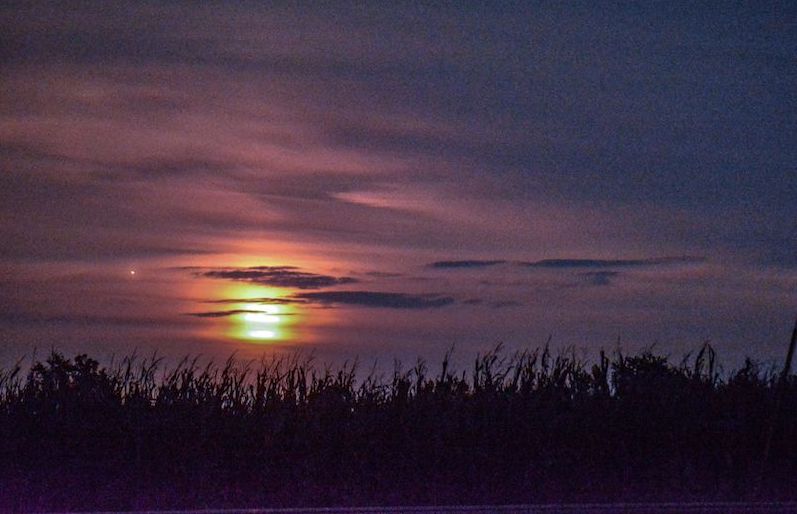
View at EarthSky Community Photos. | Niko Powe in Kiwonee, Illinois, captured Mars next to the Harvest Moon on October 2, 2020. Niko said: “There was a layer of clouds but these two’s appearance would not be denied.”
5. Jupiter. Because Jupiter is the largest planet in the solar system, some mistakenly believe it’s the brightest planet. But not so. Jupiter’s greater distance from us lets Venus and Mars, our neighbors, shine more brightly. Jupiter is nearly always brighter than Mars, though (except when Mars is at its best). At its maximum, Jupiter shines at magnitude -2.8, nearly as bright as Mars’s peak of -2.9, and brighter than Sirius, the sky’s brightest star, which shines at magnitude -1.4. Jupiter was named for the ancient king of the gods. And it has a king-like aspect, always shining at the same dazzling brightness, not changing in brightness like Mars. Plus Jupiter moves in a stately way around the sky; it isn’t tied to the sunrise or sunset like Venus. Come to know Jupiter, and you’ll enjoy spotting in your sky for much of every year. Find Jupiter’s location for each month in EarthSky’s planet guide.
6. Mercury. Surprise! The rarely-seen planet Mercury shines more brightly than Saturn at its best. Mercury can reach -1.9 magnitude. That’s brighter than Sirius, the sky’s brightest star. But – because Mercury is our solar system’s innermost planet – this world, more than any other in our solar system, is tied to the sun in our sky. It’s always seen shortly before sunrise, or shortly after sunset, and never gets very high in the night sky. Therefore its brightness is often offset by the fact that you’re viewing the planet in twilight and not in a nice dark sky. Still, Mercury’s brightness will surprise you!
7. Saturn. The ringed planet Saturn is stunning in a telescope, and it’s also an easy catch without optical aid. With the eye alone, you won’t see its rings, but you will see Saturn’s golden color and steady light. At magnitude +0.7, Saturn outshines most stars and is on a par with most of the brightest stars. Plus – because it orbits our sun beyond Earth’s orbit – it’s seen more often than Mercury by casual observers. Saturn is often around deep into the night, when its brightness contrasts with the depths of a dark night sky.
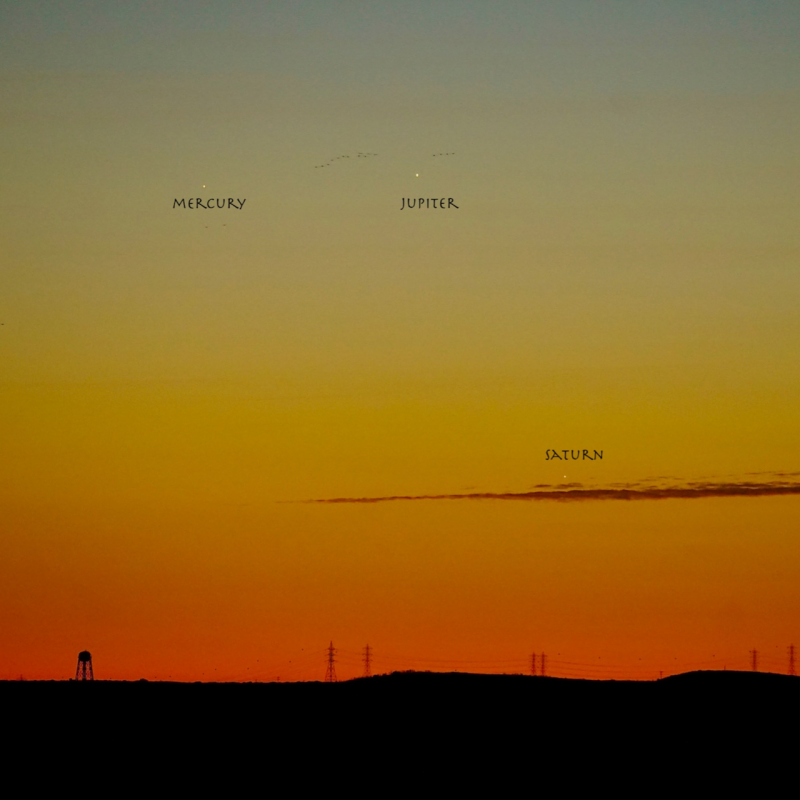
View at EarthSky Community Photos. | Dan Wyman in Oceanside, California, captured Mercury, Jupiter, Saturn and a flock of birds on January 11, 2021. Thank you, Dan! Find Jupiter, Saturn and Mercury each month in EarthSky’s planet guide.
8. Ganymede. If you’re a sky-watcher, you’ve probably seen all the objects mentioned so far without optical aid, knowingly or not. But have you seen Jupiter’s largest moon, Ganymede? Binoculars will let you spot Ganymede circling Jupiter when the satellite is at its brightest, approximately 4.6 magnitude. Ganymede takes about seven Earth-days to complete an orbit around Jupiter, and the other Galilean moons take varying amounts of time (Io nearly two days, Europa about four days, Callisto 17 days). So on any given night, you’ll find the moons in ever-shifting locations with respect to Jupiter. They look like little “stars” strung out in a line that bisects Jupiter. Thus you’ll want to use software, for example SkyandTelescope.com’s interactive Jupiter moon page, to let you know which dot circling Jupiter is Ganymede, from the location, date and time at which you’re looking. Which leads us to …
9. Io. The next item on the solar system brightness list is Jupiter’s volcanic satellite, Io. At a little larger than our moon, Io is the innermost Galilean satellite and shines at magnitude 5.0 when it’s at its best. Can you see Io – or Ganymede – with the eye alone? In theory, you should be able to. But in practice they’re not that easy to see in the glare from Jupiter itself. Some observers with renowned vision (for example, Steven James O’Meara) have claimed to have seen Ganymede with the unaided eye. But such claims are rare. You’ll likely need binoculars for Ganymede or Io, or Europa (see below). Small telescopes show all four Galilean moons in their never-ending dance around Jupiter.
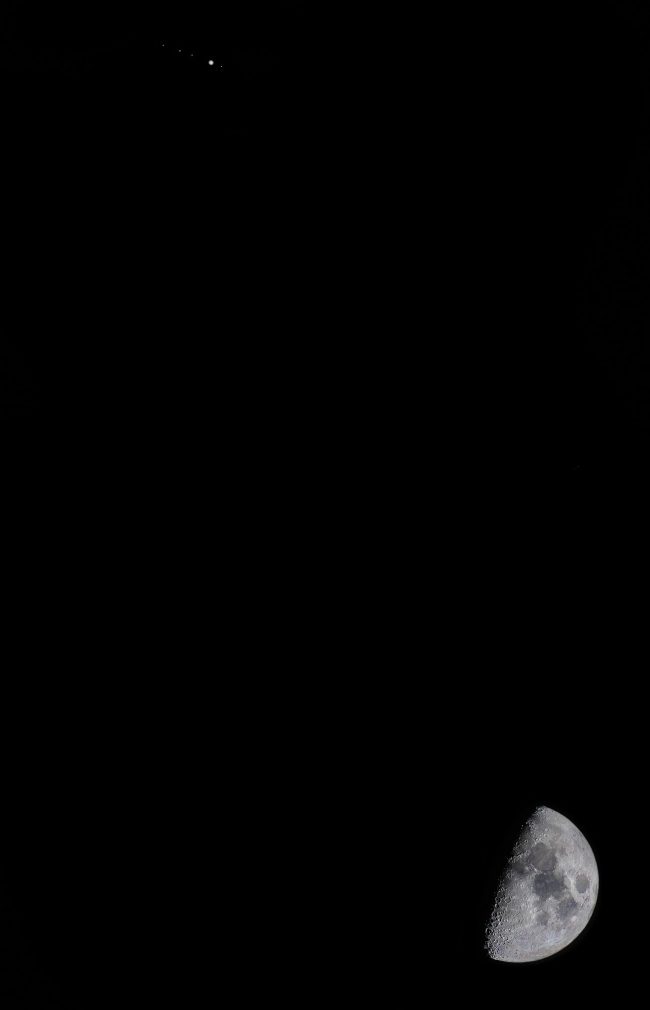
View at EarthSky Community Photos. | John Nelson was at Puget Sound, Washington, on September 24, 2020, when he captured this image. See Jupiter and its moons in the upper left? You might need to view this photo larger to see Jupiter’s moons. John wrote: “All four Galilean moons were visible. I brightened them up just a bit in Photoshop Elements so they would be easier to see in a photo that you can’t zoom in on. From left to right, the moons are Callisto, Ganymede, Europa and just to Jupiter’s right is Io.” Thank you, John.
10. Vesta. The fourth asteroid to be discovered, Vesta, is the only asteroid to make our list of brightest solar system objects. Vesta is the second-largest asteroid, after Ceres. Vesta can reach magnitude 5.1 at its closest approach to Earth. Its opposition – a highlight of the year for asteroid observers – is coming up on March 4, 2021. This is when Earth will sweep more or less between Vesta and the sun, bringing the asteroid closest to us for this year. Because it doesn’t have a bright nearby locator, as Ganymede and Io have with Jupiter, it’s best to watch for Vesta for a couple of nights in a row to see which dim “star” in the area appears to move slowly in front of the fixed star background. Try TheSkyLive for charts and other information on how to observe Vesta.
11. Europa. We bounce back out to Jupiter for the next item on the list, Europa, another of Jupiter’s four large Galilean moons. Europa is a great object to attempt to view and ruminate on, because it may harbor an ocean – and possibly life – beneath its icy crust. Europa just makes our list of the brightest objects in the solar system at magnitude 5.2. Again, we recommend using observing software, such as SkyandTelescope.com’s interactive Jupiter moon page, to know which Galilean moon is which.
12. Uranus, finally. Many know that planet Uranus is theoretically visible to the unaided eye. The seventh planet from the sun appears at magnitude 5.6 at its best. Uranus is most easily picked up with the unaided eye after first pinning down its location with binoculars or a telescope. It has a disk instead of a pinpoint image through an optical device and may even appear faintly bluish green. It is particularly easy to find on the occasions that it pairs up closely with objects easier to locate, such as Mars.
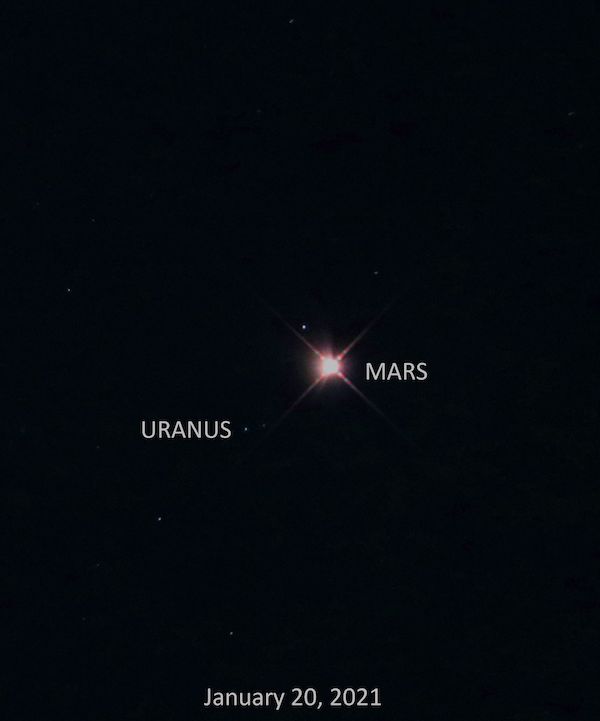
View at EarthSky Community Photos. | Victor C. Rogus in Sedona, Arizona, captured this image of Uranus and Mars through his telescope on January 20, 2021. He wrote: “The sky this evening was fair at best, but I was able to capture this image of an over-exposed Mars and the planet Uranus through thin clouds. Light takes 2 hours, 43 minutes and 27 seconds to travel from Uranus and arrive to us.” Thank you, Victor!
Bottom line: Here are the top 12 brightest natural solar system objects, in order from brightest to dimmest. If you’ve seen every one of these objects, with or without optical aid, congrats!

